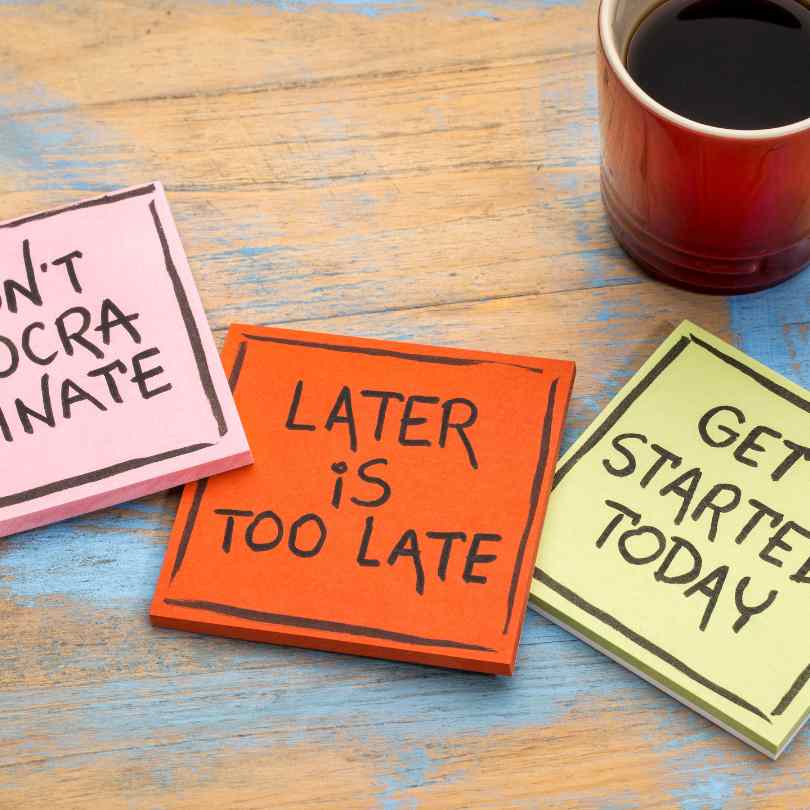
“To my mother who, whenever she asked me to do something and I replied ‘later,’ would always tell me, ‘remember Francesca, later is the brother of never’.”
Table of contents
- Introduction: The Perils of Procrastination
- Understanding Procrastination: More Than Just Laziness
- The Psychology Behind Procrastination
- The Ripple Effects of Procrastination: Workplace vs. Personal Life
- The Digital Age: Technology as a Double-Edged Sword
- Strategies to Overcome Procrastination
- Building a Proactive Mindset: Changing Habits for the Long-Term
- Real-life Stories: From Procrastination to Productivity
- Conclusion: Seize the Day, Not Tomorrow
Introduction: The Perils of Procrastination
The Age of Delay In today’s fast-paced world, the mantra “I’ll do it later” has become all too common. But as I say goes, “later is the brother of never.”
Procrastination, the act of delaying or postponing tasks, can have detrimental effects on both our professional and personal lives.
This article delves into the negative impacts of always pushing things to tomorrow and offers strategies to overcome this habit.
Understanding Procrastination: More Than Just Laziness
Procrastination is often misconstrued as mere laziness, but it’s far more intricate than just a lack of willpower. Rooted deeply in our psychology, procrastination can be a coping mechanism for dealing with emotions like fear, anxiety, or self-doubt. For some, the fear of failure becomes so overwhelming that they’d rather not attempt a task than risk not doing it perfectly.
This perfectionist mindset can paralyze individuals, making them postpone tasks indefinitely. For others, decisional procrastination takes hold, where making a choice becomes daunting, leading to a standstill. Then there’s task aversion, where the mere thought of a particular task is so unappealing that one keeps pushing it away.
Recognizing that procrastination isn’t just about being lazy but is often a response to deeper emotional triggers is the first step in addressing and overcoming it.
The Psychology Behind Procrastination

Delving deeper into the mind reveals that procrastination isn’t merely a time management issue; it’s a complex interplay of psychological factors. Here the main causes of procrastination:
- Fear of Failure: At its core, many of us procrastinate due to a deep-seated fear of failing. This fear isn’t just about not meeting a deadline or not achieving a goal. It’s about the potential judgment, shame, and self-worth that gets tied to that failure. When we’re afraid of failing, it feels safer not to try at all, leading us to put off tasks.
- Perfectionism: Closely linked to the fear of failure is perfectionism. For perfectionists, anything less than perfect isn’t just inadequate; it’s unacceptable. This mindset can be paralyzing. The pressure to produce something flawless can make starting a task seem insurmountable, leading to endless delays.
- Decisional Procrastination: Sometimes, the act of making a decision becomes a monumental task in itself. When faced with multiple options or when the stakes are high, the fear of making the wrong choice can lead to decisional procrastination. Instead of taking action, individuals become stuck in a loop of endless contemplation.
- Task Aversion: Certain tasks are inherently unappealing. Whether it’s due to their complexity, monotony, or the emotional distress they might evoke, these tasks become something we dread. Task aversion leads to avoidance behavior, where we keep pushing away the task in favor of something more pleasant.
Understanding these psychological triggers is crucial. By recognizing the underlying emotions and fears that drive procrastination, we can begin to address them, paving the way for more productive habits and a proactive approach to tasks.
The Ripple Effects of Procrastination: Workplace vs. Personal Life
Procrastination doesn’t discriminate; its consequences permeate both our professional and personal spheres, often with lasting implications.
Workplace:
- Missed Deadlines and Opportunities: Consistently pushing tasks to the last minute can result in missed deadlines, which in turn can lead to lost opportunities. Whether it’s a project proposal, a client meeting, or a product launch, delays can cost businesses valuable chances to grow and innovate.
- Damaged Reputation and Trust: Habitual procrastination can tarnish one’s reputation in the workplace. Colleagues and superiors might start to view the procrastinator as unreliable or uncommitted, eroding the trust that’s essential for collaborative environments.
- Increased Stress and Burnout: The cycle of delay, rush, and panic that accompanies procrastination can lead to heightened stress levels. Over time, this chronic stress can culminate in burnout, affecting both mental and physical well-being.
- Financial Repercussions: In a business context, time often equates to money. Delays can lead to financial penalties, lost revenue, or additional costs, impacting the bottom line.
Personal Life:
- Strained Relationships: Continually postponing commitments or failing to fulfill promises can strain personal relationships. Whether it’s repeatedly rescheduling a catch-up with a friend or delaying tasks at home, it can lead to feelings of resentment and mistrust.
- Health Implications: Procrastination in health matters, like postponing doctor’s appointments or neglecting exercise, can have direct implications on one’s health. Over time, minor issues can escalate into major health concerns.
- Missed Life Experiences: Continually putting off personal goals or activities can result in missed life experiences. Whether it’s traveling, learning a new skill, or attending events, procrastination can rob us of moments that enrich our lives.
- Regret and Self-blame: One of the most profound impacts of procrastination in personal life is the emotional toll. The accumulation of missed opportunities often leads to feelings of regret and self-blame, affecting one’s self-esteem and overall happiness.
In both spheres, the consequences of procrastination underscore the importance of understanding its roots and actively working towards overcoming it.
The Digital Age: Technology as a Double-Edged Sword

In today’s digital era, the allure of instant gratification is more potent than ever, often acting as a double-edged sword. While technology offers tools to enhance productivity, it also presents distractions that can hinder our focus and drive.
The Allure of Instant Gratification:
- Social Media Distractions: Platforms like Facebook, Instagram, and Twitter are designed to capture our attention and keep us scrolling. The dopamine hit from likes, comments, and shares can be addictive, making it tempting to check notifications rather than focusing on tasks at hand.
- The Paradox of Choice in Streaming and Online Content: With platforms like Netflix, Hulu, and YouTube offering a plethora of content, we often find ourselves spending more time choosing what to watch than actually watching. This abundance of choice can lead to analysis paralysis, where the fear of missing out on better content keeps us hopping from one option to another.
However, it’s not all doom and gloom. The same technology that offers distractions also provides tools to combat procrastination and enhance productivity.
Tools and Apps: Harnessing Technology for Productivity:
- Time Management Apps: Tools like Trello for task management, RescueTime for tracking time spent on various activities, and Focus@Will for concentration-enhancing music can help streamline tasks and improve efficiency.
- Digital Detox Strategies: Recognizing the need to unplug, several apps and platforms promote digital detox. Apps like Freedom and StayFocusd allow users to block distracting sites, helping them stay on track.
- Online Courses on Self-discipline: Platforms like Coursera, Udemy, and LinkedIn Learning offer courses on self-discipline, time management, and productivity. These courses, often led by experts in the field, provide strategies, insights, and actionable steps to combat procrastination and enhance focus.
In conclusion, while the digital age presents challenges in the form of distractions and the allure of instant gratification, it also offers tools and resources to harness productivity. It’s up to individuals to strike the right balance, leveraging technology to their advantage while being wary of its potential pitfalls.
Strategies to Overcome Procrastination

In the bustling world of today, where tasks pile up and time seems to fly, mastering the art of productivity is crucial. One of the primary challenges people face is determining which tasks to tackle first and how to efficiently manage their time. Here’s a deep dive into some proven strategies that can help:
Prioritizing Tasks
The Eisenhower Box: The Eisenhower Box, also known as the Urgent-Important Matrix, is a simple tool to help you decide on and prioritize tasks by urgency and importance. It divides tasks into:
- Urgent and important (do these immediately)
- Not urgent but important (schedule these)
- Urgent but not important (delegate these if possible)
- Neither urgent nor important (consider eliminating these)
By categorizing tasks this way, it becomes clearer what needs immediate attention, what can be scheduled for later, what can be delegated, and what might not need to be done at all.
The Two-Minute Rule: A straightforward yet effective principle. If a task takes less than two minutes to complete, do it immediately. This rule helps in clearing smaller tasks that can otherwise add up, ensuring they don’t clog your to-do list.
Break Tasks into Manageable Chunks: Large tasks can often seem overwhelming, leading to procrastination. The solution? Break them down into smaller, more manageable chunks. This makes the task seem less daunting and allows for a clearer path to completion.
The Power of the Pomodoro Technique: This time management method involves breaking your work into short, focused intervals (usually 25 minutes), known as “Pomodoros,” followed by a short break. This technique helps maintain high levels of focus and gives regular intervals to rest, ensuring that productivity doesn’t wane.
Setting Mini-Deadlines: Instead of having one deadline for a task, set multiple mini-deadlines. This approach ensures that you’re making steady progress and allows for better pacing, reducing the chances of last-minute rushes.
Incorporating these strategies into your daily routine can significantly enhance productivity. By prioritizing effectively, breaking tasks down, and setting clear, achievable goals, you can navigate through your tasks with efficiency and purpose.
Building a Proactive Mindset: Changing Habits for the Long-Term

Our surroundings and mindset play a pivotal role in influencing our behavior, including our propensity to procrastinate. By cultivating a conducive environment and adopting certain mental strategies, we can significantly enhance our productivity and overall well-being.
The Role of Environment:
- Organized Workspace, Organized Mind: A cluttered workspace can lead to a cluttered mind. Keeping your workspace tidy and organized not only reduces distractions but also enhances your ability to focus. A well-organized environment can streamline your workflow, making tasks seem more manageable and less daunting.
- Surrounding Oneself with Proactive Individuals: The company we keep influences our behavior. Being around proactive and motivated individuals can inspire us to adopt similar habits. Their drive and discipline can be contagious, pushing us to be more accountable and less likely to procrastinate.
Mindfulness and Meditation:
- Being Present in the Moment: Mindfulness is the practice of being fully present and engaged in the current moment. By practicing mindfulness, we can reduce the mental clutter that often leads to procrastination. It allows us to tackle tasks with a clear mind and focused intention.
- Overcoming the Paralysis of Overthinking: Overthinking can lead to analysis paralysis, where we become so overwhelmed by possibilities that we fail to take action. Meditation can help calm the mind, reduce overthinking, and provide clarity, making decision-making more straightforward.
Visualizing the End Goal:
- The Motivation of Picturing Success: Visualizing the successful completion of a task or achieving a goal can serve as a powerful motivator. When we can mentally “see” the benefits of our efforts, it becomes easier to overcome the inertia of starting a task.
- Creating Vision Boards and Setting Affirmations: Vision boards are visual representations of our goals and dreams. By creating a vision board, we have a constant visual reminder of what we’re working towards. Coupled with positive affirmations, they can reinforce our commitment and drive towards our goals.
In essence, by curating our environment, practicing mindfulness, and keeping our end goals in sight, we can create a holistic approach to combat procrastination and enhance our productivity.
Real-life Stories: From Procrastination to Productivity
In the vast landscape of the professional world, stories of transformation and success often stand out. These narratives not only inspire but also offer insights into the strategies and mindsets that can turn challenges into opportunities. Let’s delve into the journeys of John and Sarah, two individuals who overcame the pitfalls of procrastination and delay to achieve remarkable success.
John’s Journey: From Missed Promotions to Employee of the Month
John always had the potential to excel. His colleagues admired his knowledge and skills, but there was one thing holding him back: his tendency to delay tasks. This habit led to missed deadlines, overlooked details, and, consequently, missed promotions.
However, a turning point came when John attended a workshop on time management. He learned about the Eisenhower Box and the Pomodoro Technique, which he began to implement diligently.
By prioritizing tasks and breaking them into manageable chunks, John transformed his workflow. Within months, his efficiency skyrocketed, leading to his recognition as the employee of the month. John’s story serves as a testament to the fact that with the right tools and determination, one can overcome ingrained habits and achieve professional success.
Sarah’s Shift: Balancing Motherhood and Entrepreneurship by Beating Delay
Sarah’s journey was a tightrope walk between her roles as a mother and an entrepreneur. With the birth of her first child, she found herself juggling diaper changes with client meetings, often feeling overwhelmed. Procrastination became her coping mechanism, leading to a backlog of tasks.
However, Sarah’s shift came when she realized the power of visualization and mindfulness. She began her mornings with meditation, visualizing her day’s tasks, and setting clear intentions. She also created a vision board, placing it in her workspace, reminding her of her entrepreneurial dreams.
By being present in each moment, whether it was feeding her baby or drafting a business proposal, Sarah managed to beat delay and find a harmonious balance between motherhood and entrepreneurship.
Both John and Sarah’s stories highlight the transformative power of self-awareness, determination, and the right strategies. Their journeys remind us that no matter the challenges, with persistence and the right mindset, success is within reach.
Conclusion: Seize the Day, Not Tomorrow

The dangers of the “I’ll do it later” mindset are clear. In a world where time is our most precious commodity, we cannot afford to let procrastination steal our potential. By understanding the root causes of delay and implementing strategies to combat it, we can reclaim our time, achieve our goals, and live a life free from the shackles of “later.”
Remember, overcoming procrastination and embracing success is a journey, not a destination. If you find yourself struggling or need guidance along the way, don’t hesitate to seek support. Our expert mental and career coaches at the Assistance HUB are here to provide insights, strategies, and encouragement tailored to your unique challenges. You don’t have to navigate this path alone; let our professionals be your guiding light towards a brighter, more productive future.

